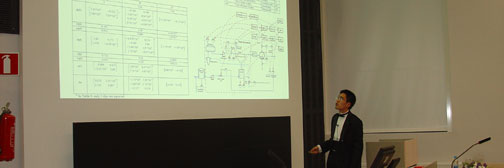| |
More than 20% of the cathode copper is annually produced by copper leaching, solvent extraction and electrowinning processes. The focus in process technology has been on research and capital intensive development of the process equipment and chemicals. However, the financial benefits gained through an advanced control system would be significant. An advanced control system would maximize the total production and increase the fraction of the first quality copper cathodes by running the process closer to the optimal operating point, and by decreasing the variation in the key process variables. The lack of adequate dynamic process models for industrial applications has, to date, prevented the development of advanced process control systems.
Therefore, the first aim of this thesis is to develop dynamic models to describe the behaviour of an industrial copper solvent process and to facilitate control system development. The second aim of this thesis is to develop an advanced control system for the copper solvent extraction process, and to verify that the performance and profitability of an industrial copper solvent extraction process can be significantly increased by utilizing the advanced process control system.
In the process model, the mass transfer of copper in the mixer-settler units is described by means of dynamic, modified ideal mixing and plug flow models. The equilibrium value for the ideal mixing model is calculated on the basis of the steady state McCabe-Thiele diagram. The unit process models are combined according to the case plant flowsheet and implemented into a process simulator. Based on the process models, control hierarchy is developed. The optimization level consists of an optimization algorithm and the stabilizing control level consists of a single input-single output control strategy employing two PI controllers or, alternatively, a multi input-multi output control strategy using the model predictive control (MPC).
The dynamic models are tested with two data sets representing the normal operation of the industrial case copper solvent extraction plant. The models follow the output copper concentration trends smoothly for the major input changes in the flow rates and copper concentrations, and the residuals between the simulated data and the industrial measurements are sufficiently small, on average 1-3%.
The performance of the control system is tested in simulation environment using the industrial data as input. Compared to manual control, the variation in the rich electrolyte copper concentration was decreased by 70 – 80 % with the PI controllers and 80 – 90 % with the model predictive controller. The copper mass production was increased by about 3 – 5 % with both control strategies.
The modeling and control results are very encouraging for the further testing of the control system in an industrial copper solvent extraction plant.
Thesis electronical version can be downloaded from here
This info last modified 28 Apr 2024 by Jerri Kämpe-Hellenius
|

